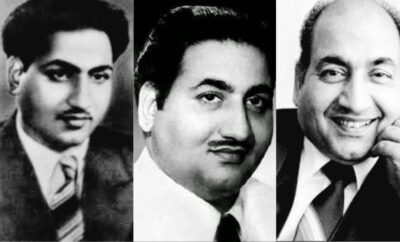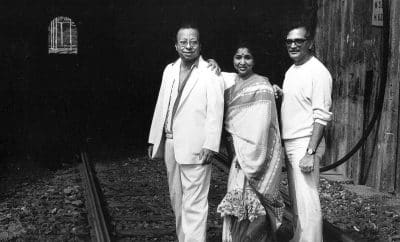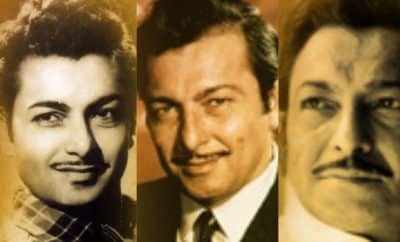Song Sketch
Savere Ka Suraj – An Invaluable Art Piece
Pièce d’art polyvalent
An artist however he is talented and successful becomes caricature of his own style eventually as this style is what has given him the name and fame. But then there are some craftsmen who after years of glory also dare to do things differently. Do things which they have conviction for and which they believe will stand tall. O.P.Nayyar was one such artist.
I would call him an artist and not composer or music director because artist is beyond any definition. He is in love with his craft. His creativity flows from his expression of life. OPN was a man of high taste. His fondness of finer things in life reflects his taste in music too. His conviction for his own style of composing and his music was so strong that he never compromised by getting to deliver like his contemporaries whereas many big names had to do it.
Similarly there was another artist of such high calibre who always did what he wanted to do and never what was obviously expected. He was Kishore Kumar. There was a serious artist with great talent behind his self created comic image ; When these two genius have come together , they delivered pièce d’art polyvalent which means a piece of versatile art.
Why versatile ? Because both OPN and KK never undergone any formal training of Indian Classical Music and yet after tasting sucess for nearly two decades in their popular form of music, they both delivered a composition which was absolutely classical by theory and amazingly melodious in terms of output.
Savere Ka Suraj…..is based on raag Yaman Kalyan and Taal Jhaptaal. There are very few songs in HFM which are built over Jhaptaal as it’s a Taal of ten matraa. Reason is the length of beats cycle . The ‘Sam’ i.e. first beat of Taal on which the first note of the sign line (first line of song) begins would repeat only once the cycle of ten beats is complete. This means the length of the sign line by words and by melody has to be extended till one cycle of ten beat is complete. This is not an easy job.
Also, OPN created a tune which is having disjointed structure. The notes are note interplaying in sequence. ‘Savere Ka Suraj / Tumhare Liye Hai / Ke bujhte diye ko na tum yaad karna’ these three phrases are on seperate clusters of notes and there is no bridge note in between to maintain the harmony, yet it sounds so beautiful when listen to entire line. That’s the brilliance of composer.
His versatility doesn’t stop here. For a typical in-party-broken heart-sad song, he composed a classical song with minimal orchestration. For somber mood he used his favourite combination of Piano and Strings (he used same in Dil Ki Awaz Bhi Sun) and to express the pathos he has used Sitar and Sarod and still the song doesn’t sound heavy in classical mould.
On the other hand, Kishore Kumar is flawlessly amazing. The phrase ‘Ke bujhte diye ko na’ begins from ‘Tumhare liye hai’ now the word ‘hai’ is on ‘Sa’ and the words ‘ke bujhte diye’ are on ‘Pa Ni Sa Dha Pa’ so he shifts from ‘Sa’ to directly ‘Pa’ four notes without any intermediate bridge note that could helps to take the pitch higher. And he sings absolutely flawlessly.
In my personal opinion, this is one highly underrated and hidden gem of both O.P.Nayyar and Kishore Kumar.
https://youtu.be/1zhkt5LQvzg




Dilip Apte
February 17, 2020 at 9:44 am
Wah Kunal- you bring out the intricacies of – Savere ka Suraj – perfectly
Dilip Apte
February 17, 2020 at 9:45 am
Wah Kunal- you bring out the intricacies of – Savere ka Suraj – perfectly
Ajay
February 17, 2020 at 11:59 pm
Nice write-up, good subject. Highlighting two “untalented” Legends. This was my favorite song in college days and I have sung this song, many times, in college days.
Uttam Padukone
February 18, 2020 at 11:17 am
Couple of points about this particular song:
1) OPN has repeated his rarely used penchant for one word / two swaras in this song. Listen carefully to the word Tumhare in the “Savere ka sooraj, Tumha-re liye hai!” Kishoreda splits the word into Tumha and Re. And when singing, sings Tumha in lower bass note in his, what is typically referred to as “Baahar ki aawaz” while the Re is in a higher pitch in an “Andar Ki aawaz”.
Another example of this baahar-andar aawaz is Chal Akela from Sambandh where the word is “Akela” – split into Ake and La by Mukesh.
2) The range of notes in this song is truly incredible. Listen for instance the start of the second stanza – “Sabhi waqt ke aage…” Listen specifically to “aage” – only Kishore Kumar has that kind of bass capability (besides KL Saigal perhaps but can Saigal hit those high notes in the third stanza?)
Then the third stanza starting with the high notes of “Chiraag Apni dharti ka bujhta hai jab bhi” Kishoreda suddenly is called to sing a lovely full timbre – “Sitaare to ambar ke rotey nahi hain”. And then again the same high notes and once again the beautiful “kinare tho sagar ke rotey nahi hain”.
The post third stanza singing is something that induces Goosebumps. As the song ends, the third singing of “Tumhare liye hain….” echoes in your ears… never to be stilled.
Pingback: Carnival of Blogs on Golden Era of Hindi Film Music – February 2020 – The world is too small? or Is it?
Moe Ali
July 2, 2021 at 12:00 am
That’s amazing. I did not know that OPN devised these word splitting technique to his songs by KK and Mukesh. OP was a master of music, song and romance. No one, I repeat, no one can even get close to his vision and delivery. It’s mesmerizing music, the tunes, lyrics and singers. almost puts people in a trance.